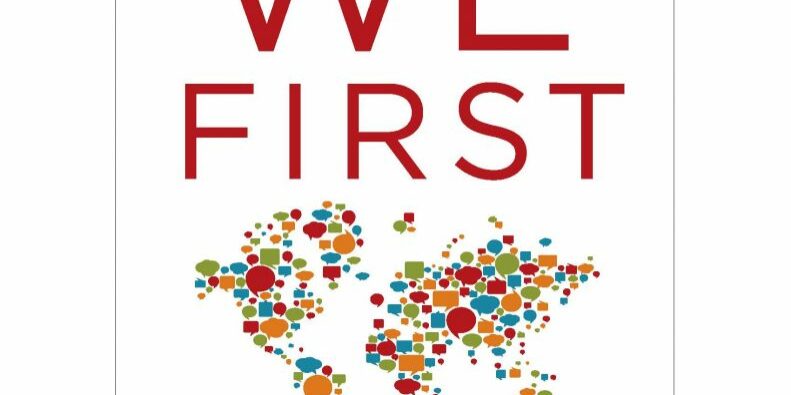We live in an exciting era – as we begin to realize that we are all interconnected, that we depend on each other and the environment to support us, the paradigm changes. It’s no longer going to work to just look out for Number One because we can’t do it alone. My hope, however, is that together we can make monumental changes. In Simon Mainwaring’s awesome new book, We First, he points out that Social Media helps us to come together to not only build better businesses, but to build a better world.

Simon is not only a branding/advertising guru, but a family friend, so I was able to sneak a few moments of his precious time to tell us about his book, which BTW is just out this week. So if you are a business owner, an entrepreneur, or a mom who enjoys creating change through social media, We First might be a great Summer read.
SU: Why did you write We First, and what do you see as the role of social media in social change?
SM: I wrote We First for personal and professional reasons. On a personal note, as a father, I wanted to create a better world for my children. My father, having recently passed away, made me very mindful of the finite time we have on this planet. I saw my kids getting old and I thought, “I want to make a difference.” On a professional note, I was responding to a challenge that Bill Gates gave at the World Economic Forum where he said that government and philanthropies can’t fix the world on their own, and that we have to get the private sector involved. I responded to that, not as a tech geek, but as a branding consultant who recognized that it is possible to create movements around new thinking and behavior if you can connect with people emotionally. So what I responded to with social technology was the amazing ability to connect with people emotionally in real-time, all around the world at virtually no cost. The importance of this for a woman, whether you’re a mother or a young millennial, is that it gives you the capacity, for perhaps the first time, to fulfill your daily wants and needs, or to fulfill your responsibilities as a mother, but also to minimize the damage that your consumption has on the world and maximize your positive impact.
SU: How do we actually use social media to have a positive impact?
SM: Firstly, there are direct ways in that you can sign petitions that encourage greater corporate social responsibility from brands, whether the issue is organic milk, the use of grown hormones, the carbon footprint of a company or how they treat their employees. You can effectively lobby as a group through platforms like Facebook and Twitter to encourage that shift. But I think the true opportunity here is more systemic than this. Until now, consumers have never had a way to push back on brands. They’ve never had a voice or media platform to express themselves. That’s what social media provides, and it is important for this reason: it allows them to leverage their buying power like never before. If you walk down the shopping aisle and hold up a GoodGuide app and scan the barcode of a certain product and elect to choose the product with the greatest social benefit over a similar brand that has a lesser social benefit, that’s going to hurt that company’s bottom line.
Beyond that, you can communicate with your peers, your friends, your family, about the things you care about online. You can talk about the brands you like and the brands you don’t like on Facebook and Twitter. You can share your frustrations when you’ve had a bad customer experience. Basically, social media operates as a real-time focus group of millions of people that brands can tap into, and if they’re doing a good job it will work in their favor but if they’re doing a bad job it will work against them. As a consumer, as a mom, as a young millennial, your responsibility and opportunity is from purchasing products from responsible companies, sharing what you care about with your peers, investing in socially responsible companies and, finally, by assuming the role of a thought leader who encourages others to get behind causes that are meaningful to you because they have a positive impact on your life, they life of your family, and the future of your children.
SU: Can every woman, from a teenager to a grandmother, become a thought leader?
SM: This is true because these tools are available to everybody. Obviously, the younger generation that has grown up with this technology is much more adept at not only using it to its full extent, but also using it in ways that not even the designers imagined. But irrespective of technology, the currency we are all trading in, whether we are a consumer or a brand, is emotion. We’re looking to connect with people around what we care about. There are wonderful examples of young people starting organizations or non-profits that benefit social causes but then again, education and health care for the baby boomer generation is a huge thing. The only caveat is that you do need to maintain a fascination with this technology. You have to realize that this is a way for you to connect with people around what you care about, and that can ultimately be very powerful.
SU: Is social media losing some of its impact because there is so much noise out there that it can become either overwhelming or meaningless?
SM: We need to be mindful that we’re in the early stage of the adoption of social media in that, while consumers, particularly in the developed world, have embraced it to a large extent, we still have a long way to go before it’s fully integrated with brands and with political institutions until it is seamlessly used throughout culture. I do believe that in three or four years time, we will look back and won’t be able to remember a time when consumers couldn’t communicate about brands using multiple channels for free. That said we are in a period of transition.
At first the Internet provided us with a wonderful resource to a seemingly endless amount of information, and we just gorged ourselves on it. It has now gotten to the point where there is so much information that it’s absolutely overwhelming, in which case we are now starting to filter out that information in terms of what is meaningful us. So in terms of social media being a tool of positive social transformation, the fact that meaning is now the filter is a good thing. People don’t want to be overwhelmed with endless spam, endless information, that doesn’t interest them. The tools are actually allowing them to filter out what’s not important to them.
We’re also starting to see a second trend, which is that consumers are stepping into their role as architects of culture. At first, these tools were mostly a distraction or entertainment. We could talk about what we had for lunch or what we thought of the latest movie, but now more and more groups are getting organized and waking up to the potential of collective action around shared values. So while there is a lot of noise out there, the signal is getting clearer because consumers are getting more sophisticated and organized in their use of these tools.
Over time, I think the third trend we will start to see is that, once there is an active and equal dialogue going on between brands and consumers, we will see this go to a whole other level. There will be direct engagement between a brand and its community around substantive efforts. Why? Because when a company does something meaningful, it’s well received allowing them to build community that builds loyalty, goodwill and profit.
SU: What exactly are the filters that women and moms can use so they can make a contribution in the middle of their busy lives?
SM: In terms of managing social media itself, there are tools like Hootsuite and Tweetdeck, which allow you to see in a single screen not only the tweets of all the people in your community, but when you’re being mentioned, and your Direct Message conversations. So that’s one way to manage it in a snapshot format. But the beauty of social media is that it’s now having an impact on shopping, in that shopping is becoming a social experience. Not only can you use Good Guide to scan the barcode of a product to look at its social impact, you can share what you just bought and why with your peers in real-time. Or you can check in where you are shopping and why. Or you can go online and look at a website like brandkarma.com when you’re buying a big ticket item like a washing machine or a car, and look at the impact that the brand is having on culture at large, so you’re making an informed decision. The benefit is enabling people to be mindful, rather than mindless, shoppers as well as the ability to share that information once they do so. The future shopping will become increasingly social in that we will talk about what we’re buying with other people, it will become mobile and it will become driven by gaming in that we will be incentivized to reach different levels and to earn social currency and to share that with friends and we will receive discounts and bonuses on that basis. So you can see it coming together. The more you buy products that have a positive impact and the more you share them and the more you’re rewarded for sharing them, you can create a cycle of positive consumption, or what I call ‘Contributory consumption’ rather than overconsumption that lines the pockets of the brands but does more damage to the planet.
SU: What about green/good washing?
SM: Greenwashing is a critical problem right now in that the label of ‘green’ is effectively meaningless as more brands misuse it. The same issue is going to rise with the word ‘purpose’ in that every company will be talking about the purpose behind its products and services whether they are doing that authentically or not. The great comfort the internet provides, however, is that the consumer’s radar as to what is disingenuous or dishonest is very sensitive, and consumers are now armed with so many social media tools to expose companies that are greenwashing, causewashing, or localwashing.
It’s up to the customers – the mom’s and young millennials -to embrace this role of social activism and say “I now have the technology and tools to be mindful of my own shopping and to celebrate and admonish those brands on the basis of their social responsibility, and together, as a group, we can create a shift towards a practice of capitalism that is more sustainable, that is kinder to the planet, and that allows us to feel more hopeful, rather than hopeless for the coming years, not just for ourselves but our kids as well.”



